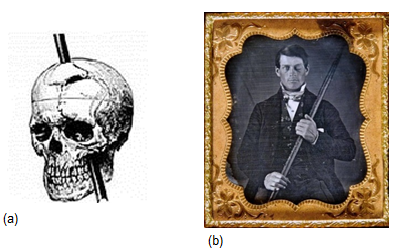Phineas P. Gage
(1823 - May 21, 1860) was an American railroad construction foreman remembered for his improbable survival of an accident in which a large iron rod was driven completely through his head, destroying much of his brain's left frontal lobe , and for that injury's reported effects on his personality and behavior over the remaining twelve years of his life—effects so profound that (for a time at least) friends saw him as "no longer Gage."

Figure 6. Phineas Gage, the iron's path (b) is from the collection of Jack and Beverly Wilgus.
Phineas Gage influenced nineteenth-century discussion about the mind and brain, particularly debate on cerebral localization , and was perhaps the first case to suggest that damage to specific parts of the brain might induce specific personality changes.
A report of Gage's physical and mental condition shortly before his death implies that his most serious mental changes were temporary, so that in later life he was far more functional, and socially far better adapted, than in the years immediately following his accident. A social recovery hypothesis suggests that his employment as a stagecoach driver in Chile provided daily structure allowing him to regain some lost social and personal skills. All of this points to the remarkableness of the brain, the psychology of it, and its recoverability.


